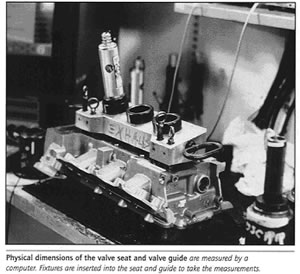I don't know of any aftermarket supplier who can provide this type of sophisticated gauging equipment for a rebuilder. Equipment suppliers I've talked to aren't sure how they are going to meet the challenge of providing the measuring equipment for rebuilding the latest engine designs. And even if the equipment were available, the cost would be out of reach for most shops

Even the way the heads were physically handled in the factory would put many rebuilders to shame. After the final finishing cuts are made, I didn't see another piece of metal touch any finished surface.
Whenever the heads were placed with the deck side down, it was on a piece of plastic to prevent scratching. Even the racks used to store the heads have plastic-coated pegs to avoid damaging the heads. Because the finish is so smooth, a special protective packaging must be used if the heads are shipped out of the factory.
As I was told about the special packaging used to protect the heads, I thought about all the times I've seen a rebuilder toss a set of newly machined heads into a bed of a pickup to deliver the heads to a customer. And how many times were those heads taken out of the pickup bed and dropped on a dirty workbench?
Do we need this level?
As aftermarket rebuilders, do we really need to match the machining and measuring precision of the OEs? I'm afraid that we do. For starters, the onboard diagnostic system, including the sensors and the programming, was designed to operate on an engine
Some rebuilders have a mistaken notion tat their work won't have to meet original standards if the engine is out of the original emissions warranty. That idea is wrong. The OBD-II system on a car doesn't measure time or how many miles it has been driven because the computer system will continue to monitor emissions as if the vehicle were new.
OBD-II will set a MIL (malfunction indicator light) whenever the system detects a problem within the engine or when emissions exceed 1.5 times the standard at the time the engine was certified.
The current emission standards set by the EPA are tight, and they will get even tighter. The recent proposed change in standards, which will probably become official by the end of the year, will cut current NOx emissions levels by 90% by 2004. A margin of 1.5 times the standard doesn't give a rebuilder a large margin for error. The emission levels are so low, any increase in emissions can quickly exceed the 1.5 time level and set a fault light.
The risk of setting a fault light will be greatest during cold starts. For approximately the first 90 seconds after a cold start, the mixture is rich and the catalytic converter isn't hot enough to effectively do its job. Any problems with the rebuild that interfere with emission control are most likely to show up following a cold start.
